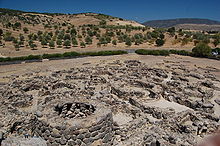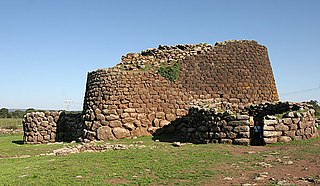
The nuraghe, or nurhag, is the main type of ancient megalithic edifice found in Sardinia, Italy, developed during the Nuragic Age between 1900 and 730 BC. Today it has come to be the symbol of Sardinia and its distinctive culture known as the Nuragic civilization. More than 7,000 nuraghes have been found, though archeologists believe that originally there were more than 10,000.

The Sherden are one of the several ethnic groups the Sea Peoples were said to be composed of, appearing in fragmentary historical and iconographic records from the Eastern Mediterranean in the late 2nd millennium BC.

Domus de Janas are a type of pre-Nuragic rock-cut chamber tomb found in Sardinia. They consist of several chambers quarried out by the people of the San Ciriaco through Ozieri cultures and subsequent cultures, resembling houses in their layout.
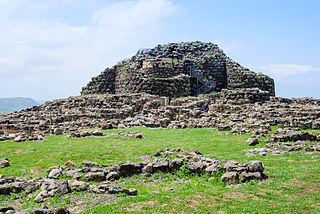
Barumini is a comune (municipality) in the Province of South Sardinia in the Italian region of Sardinia, located about 50 kilometres (31 mi) north of Cagliari and about 15 kilometres (9 mi) northeast of Sanluri.
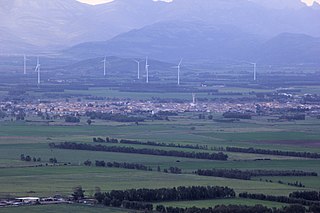
Pabillonis, Pabillonis in the Sardinian language, is a comune (municipality) in the Province of South Sardinia in the Italian region Sardinia, about 50 kilometres (31 mi) northwest of Cagliari and about 15 kilometres (9 mi) west of Sanluri.

The Nuragic civilization, also known as the Nuragic culture, was a civilization or culture on the Mediterranean island of Sardinia, Italy, which lasted from the 18th century BC up to the Roman colonization in 238 BC. Others date the culture as lasting at least until the 2nd century AD and in some areas, namely the Barbagia, to the 6th century AD or possibly even to the 11th century AD.

The Bonnanaro culture is a protohistoric culture that flourished in Sardinia during the 2nd millennium BC, considered to be the first stage of the Nuragic civilization. It takes its name from the comune of Bonnanaro in the province of Sassari where in 1889 the eponymous site was discovered.

Marmilla is a natural region of southern-central Sardinia, Italy. Etymology The name "Marmilla" comes from the vast rounded hills, probably resembling udders. Another hypothesis is that according to which given the presence of many marshes in the area, the landscape could appear dotted with "a thousand seas". Tourism in the Marmilla can rely on various factors ranging from environmental assets, to the numerous Nuragic centers in the area, to architectural works. In particular, we note:
The Ozieri culture was a prehistoric pre-Nuragic culture that occupied Sardinia from c. 3200 to 2800 BCE. The Ozieri was the culmination of the island's Neolithic culture and takes its name from the locality where early findings connected with it have been found, the cave of San Michele near Ozieri, in northern Sardinia. The Ozieri existed contemporaneously with the Arzachena culture, sharing some similarities, and its influence also extended to nearby Corsica.

Sardinia is the second-largest island in the Mediterranean Sea and an autonomous region of Italy. Tourism in Sardinia is one of the fastest growing sectors of the regional economy. The island attracts more than a million tourists from both Italy, from the rest of Europe, and, to a lesser degree, from the rest of the world. According to statistics, tourist arrivals in 2016 were 2.9 million people.

The Giants of Mont'e Prama are ancient stone sculptures created by the Nuragic civilization of Sardinia, Italy. Fragmented into numerous pieces, they were discovered in March 1974 on farmland near Mont'e Prama, in the comune of Cabras, province of Oristano, in central-western Sardinia. The statues are carved in local sandstone and their height varies between 2 and 2.5 meters.
Giovanni Lilliu, was a renowned archeologist, academician, publicist and politician and public figure and an expert of the Nuragic civilization. Largely due to his scientific and archeologic work in the Su Nuraxi di Barumini in Sardinia, Italy, the site was inscribed on the UNESCO list of World Heritage Sites in 1997.

The Nuraghe La Prisgiona is a nuragic archaeological site, located in the Capichera valley in the municipality of Arzachena Costa Smeralda in the north of Sardinia. It consists of a nuraghe and a village comprising around 90–100 buildings, spread across 5 hectares. Findings from this site are in many cases unique in Sardinia, particularly with regard to decoration and use. Due to the large extent and number of buildings the site is considered unique in North-East Sardinia. There is also some evidence for occupation during Roman and medieval times. The Giants' grave Coddu Vecchiu is located nearby.
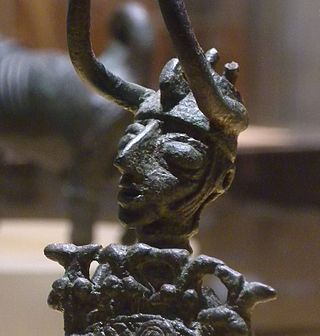
The Nuragic bronze statuettes are typical Nuragic Sardinian bronze sculptures of the final phase of the Bronze Age and the early Iron Age.

The nuragic holy well is a typical Sardinian hypogean Bronze Age structure for the worship of the waters. Scattered throughout the island, along with the Giants' grave and the megaron temples, they testify to the deep religiosity of the Nuragic populations. These temples were a place of pilgrimage and ceremonies: it is believed that at certain times of year the various nuragic populations of the area gathered together in their vicinity.

The nuraghe Is Paras is an archeological site of Isili, a town in the historical region of Sarcidano, province of South Sardinia.
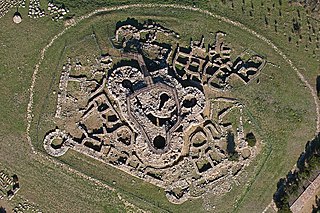
The nuraghe Genna Maria is an archaeological site in the comune of Villanovaforru, province of South Sardinia.

The Nuragic sanctuary of Santa Vittoria is an archaeological site located in the municipality of Serri, Sardinia – Italy. The name refers to the Romanesque style church built over a place of Roman worship which rises at the westernmost tip of the site. The Santa Vittoria site was frequented starting from the first phase of the Nuragic civilization corresponding to Middle Bronze Age. Subsequently, from the late Bronze Age to the early Iron Age, the place became one of the most important expressions of the Nuragic civilization and today it constitutes the most important Nuragic complex so far excavated.

Nuraghe Su Mulinu is an archaeological site located in the territory of Villanovafranca, in the province of South Sardinia.





